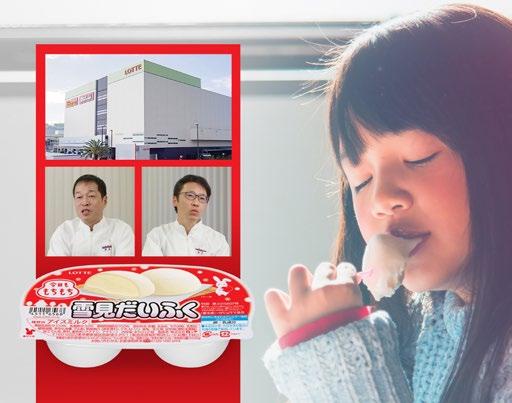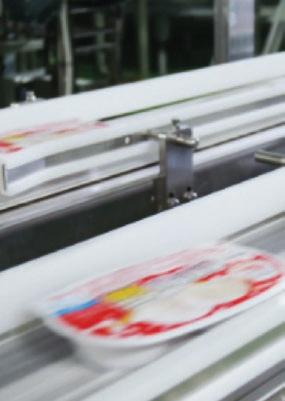
4 minute read
MITSUBISHI ELECTRIC
ICE CREAM MAKES CHEWY ENCOUNTER WITH DIGITAL MANUFACTURING

Lotte is a leading manufacturer of confectioneries, ice cream, general merchandise, and others. (Image Source: Mitsubishi Electric Corporation)
Since its launch in 1981, Lotte’s Yukimi Daifuku has been loved by people of all ages as a popular Japanese household favorite. Many have tried the unforgettable flavor and texture of the vanilla ice cream balls wrapped in soft, chewy mochi rice cake. “Delicious whenever eaten, regardless of the season,” however, to achieve that deceptively simple goal of consistent texture, quality and taste is actually more difficult than most people would have thought. To solve this challenge Lotte has introduced Mitsubishi Electric’s e-F@ctory to the production of Yukimi Daifuku.
“Before introducing e-F@ctory, there was an issue of inconsistency of the rice cake quality,” said Hiroshi Sugimoto, Manager of the Facilities Department, Urawa Plant, LOTTE Co., Ltd. “When wrapping the ice cream, the hardness of rice cake used to vary depending on the temperature and water content. Some operations were dependent on people, and losses arose out of the need to finely adjust the machine parameters.”
“The e-F@ctory system allows us to conduct improvement activities such as enhancing the operating rate, stabilizing quality, and optimizing staffing for production activities. The extendibility of the system, depending on what we want to do, was also appealing,” Hiroshi Sugimoto added. At each of the Yukimi Daifuku production lines the state of the product and the operating status of the machines is collected by PLCs installed in each process. Vast amounts of data, such as vibration data from the rice cake hopper to data from the conveying inverters is collected. All of the data can be understood in real-time not only through the overall SCADA monitoring system, which is installed in the control room, but also through on-site computer displays.
“By introducing this system, data became centralized, making it possible to view and investigate conditions whenever we want,” remarked Hiroshi Akimoto, Section Manager of Facilities Department, Urawa Plant, LOTTE Co., Ltd. “Because the data volume is extremely high, having all the data centralized in one place has a positive effect. One big benefit is that we can now gather and analyze data and conduct data diagnostics using a real-time data analyzer. This system not only helps us stabilize the state of the rice cakes used for the Yukimi Daifuku, but also promotes improvement activities within the plant.”



The Real-time Data Analyzer (above) is running in the Mitsubishi Electric “MELIPC” industrial PC (below) where it gathers and analyzes data and conducts diagnostics. (Image Source: Mitsubishi Electric Corporation)
Rice cakes are made by steaming and kneading (left), then combined with cold ice cream (right). The rice cake temperature is key to Yukimi Daifuku’s soft and supple texture, which is the key feature of this popular ice cream. (Image Source: Mitsubishi Electric Corporation).

“Another benefit is the adjustment of the blending ratio of rice cake and ice cream,” Hiroshi Akimoto continued. “This was usually done by experienced operators, who monitored the state of the rice cakes as they come out of the wrapping machine by kneading them with their fingers. We thought it would be great if we could automate this process. By automating such processes, which were conventionally performed based on human senses, and by capturing signs of any poor quality of the wrapped rice cakes beforehand, we can eliminate problems. That was our ultimate goal.”
“As you know, ice cream is a cold material. This cold ice cream is combined with rice cake, which is warm when it is made,” said Takayuki Manako, Executive Director & Plant Manager of Urawa Plant, LOTTE Co., Ltd. “This technical aspect of combining a cold item with a warm one in a good balance is what makes Yukimi Daifuku a complex product. But I think this challenge is something that inspires us to find new ways to overcome it. The temperature in the manufacturing room varies all year round. We strive to maintain consistent conditions, but at the same time, we try to reliably create even better conditions. We introduced the e-F@ctory manufacturing concept with the expectation of realizing this in the future.”
“In the course of daily production, machines do not operate in the same condition every day. Previously experienced staff members checked and adjusted the settings of the machines,” Takayuki Manako continued, “but with e-F@ ctory we can visualize the condition of machines and the machines themselves can issue instructions to make adjustments. Another thing is that maintenance and failures are unavoidable with machines. We expect that these can also be better managed by using e-F@ctory’s symptom management features.”
“The use of IoT has only just been introduced to the production of Yukimi Daifuku, however, the Urawa Plant has many other lines making chocolates and ice creams, so Yukimi Daifuku is not our only challenge,” Takayuki Manako added. “We aim to horizontally deploy this system and construct a smart plant in which ‘symptom management’ and ‘operating rate improvement’ are implemented on numerous lines. Stable plant operation and manpower savings will eventually make a major contribution in terms of costs and so on. If we consider LOTTE as a whole, our goal is to further evolve this technology and extend it to other plants.”
https://eu3a.mitsubishielectric.com/










